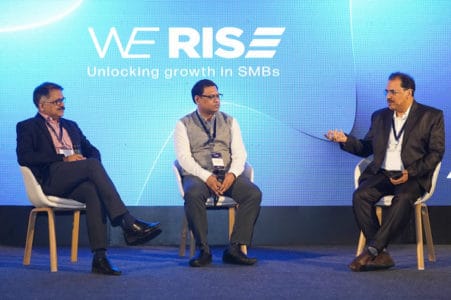– B Swaminathan | IMAWS
Indian economy predominantly depends on how the SMEs are functioning. India’s major SMEs are still not ‘corporatized’. Even though the impacts of the global phenomenon like maintaining books, and creating emails are increasing even at grass-root levels, according to the market leaders, the difference in the generations is not allowing organizations to decide quickly on advanced technologies.
Ramakrishnan Sudarshan, fondly called Ramki was a former CIO of the UB group. During his long career as the chief of technology with Top Leadership ‘Business – IT’ Strategist, Ramki is a technology thought Leader and a Globally recognized CIO with a distinguished track record of providing leadership in CIO roles for over 18 years that include the implementation & execution of various large-scale projects in cutting edge & emerging technologies such as Cloud, IoT, RPA, Mobility & Rapid Application Development (RAD) Platforms. In his new role as a consultant, Ramki is consulting for various small to large enterprises.
He gets on a chat with CMR for an interaction on the way SMEs should engage and involve in IT. Edited Excerpts.
CMR: What are the key challenges today for most SMEs”s are not able to afford a CIO?
Ramki: One of the significant challenges for SMEs is the high cost of hiring a full-time professional with specialized skills in managing information technology strategy, systems and processes. SMEs with limited resources and budgets may find this to be a significant expense. Moreover, most small and medium-sized enterprises are not in a position to understand and appreciate the benefits of having a CIO to spearhead the technology strategy for the organization. They are not able to appreciate the strategic importance of Information Technology and the value that the CIO can bring in terms of optimizing business operations, improving operating efficiencies, bringing down costs and improving the overall profitability of the business by leveraging technology strategically and optimally.
CMR: With respect to using technology for growth, how do you compare the SMEs of India with their counterparts in Western Countries?
Ramki: When it comes to leveraging technology for growth, Indian SMEs have been increasingly adopting digital tools and technologies to improve their operations. However, when compared with their counterparts in Western countries, Indian SMEs do face significant resource constraints including access to capital, good talent and infrastructure. While on one hand, some of the SMEs have been slow in adopting new technologies due to concerns around data privacy, security and regulatory compliances but on the other hand many of them have been quick to adopt mobile and cloud technologies to grow their market reach thereby increasing their top line and bottom line. Additionally, the fact that Indian SMEs are known for their entrepreneurial spirit and agility, they are quick to respond to opportunities that come their way. Overall, while there may be short-term challenges facing Indian SMEs in adopting new technologies, the growth of the Indian technology industry and increased availability of affordable digital tools will help them to leverage technology effectively to drive growth and innovation in the coming years.
CMR: What is the right time/situation/turnover an SME should seriously consider onboarding a Virtual CIO or CIO as a service?
Ramki: Well, this could depend on several factors such as the size of the business, its growth trajectory and its strategic goals. Some of the situations that might trigger the SME to seriously consider availing the services of a Virtual CIO or CIO as a service are: –
- Rapid Growth: SMEs experiencing rapid growth in business or planning to expand their operations to different geographies and/or products and services might immediately need robust technology platforms, processes and systems to support the scaling of operations and increased customer base and business volume.
- Technology Challenges: SME is facing serious challenges with the existing IT infrastructure, systems and processes or struggling to keep up with the changing technology trends. In this situation, having guidance from an experienced CIO in setting up a robust technology landscape and streamlining the processes will help the business to leverage technology more optimally.
- Cyber Security challenges: With the increased digital exposure, SMEs need to tackle the growing cyber threats and protect their intellectual properties. Engaging a Virtual CIO would help implement robust cybersecurity measures and build an effective risk management strategy.
- Regulatory Compliance issues: If the SME is from an industry that requires several mandated compliances to be met, engaging the services of the CIO will help set up strong systems and processes to meet the regulatory compliances. This will help the SME to meet regulatory compliance needs and avoid costly penalties and legal issues that might come up in case of non-compliance.
CMR: One problem in Indian family-run businesses is the second or third generations had started entering the business. However, they are unable to transform the organizations due to generation gaps. What is your view on this?
Ramki: This is very true and is found in many family-run businesses. However, this can be overcome by taking some proactive steps and bringing in the desired cultural change. First and foremost is the need to have an open communication flow between the older generation and younger generation as this will allow both of them to understand and appreciate each other’s perspective, values and goals and they can effectively work towards the common goal. Encouraging collaboration between different generations will help build mutual respect and trust among people. Empowering the younger generation with the desired authority and responsibility to take critical business decisions that will drive the organization’s growth. Last but not least is to use the services of external consultants and/or advisors to get an outside perspective who can guide both generations and facilitate discussions and agreements between them on strategic priorities.
CMR: What are the key things an SME owner should keep in mind before onboarding a CIO for consulting?
Ramki: Onboarding a CIO for consulting is a very important and critical decision for an SME owner and he has to keep several things in mind before proceeding with it.
- Clarity of CIO Role: It is important to clearly lay out the roles and responsibilities and expectations of the CIO in terms of the areas where he has to provide consulting such as IT Strategy, Digital Transformation, Industry 4.0, Cybersecurity, Governance, IT Operations Management etc.
- Identify the Business Needs: Assessing the current IT landscape in terms of systems, processes, and infrastructure and identify the areas where the CIO needs to focus on.
- Evaluation of CIO’s Profile: Evaluate the profile of the CIO to ensure that they have the requisite qualification, industry experience and technical prowess to provide the consulting services.
- Engagement Terms: Define the scope of the engagement in terms of scope of work, deliverables, success criteria, timeframe, costs and payment terms.
- Budget: Determine and allocate the necessary resources in terms of people, and capital to ensure that there are no impediments in carrying out the additional investments that may be required to meet the strategic goals identified.
CMR: What are your suggestions for the IT leaders who are consulting SMEs? What they should do and what they should avoid.
Ramki: In my view, the IT leaders who are consulting SMEs should ensure that the services offered by them are effective, adds value and serves the purpose. The things that they should be doing:
- Conduct a comprehensive assessment of SME’s existing IT systems, processes, and infrastructure and identify areas that need improvement
- Develop an IT Strategy based on the above assessment that aligns with the SME’s strategic business goals and priorities.
- Develop an IT Solution landscape with costs, implementation timeframes and other resource requirements in terms of manpower, infrastructure etc.
- Establish IT processes, data management and governance framework
- Develop a Cybersecurity strategy based on the current threat landscape and implementation of cyber security measures including policies and solutions.
The things that they should avoid
- Failure to assess the SME’s unique needs and going with one size fits all approach
- Recommending complex solutions that are difficult to manage and maintain over a long time
- Recommending tools and technologies that are fashionable but do not align/fit with their strategic goals and priorities













